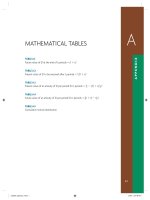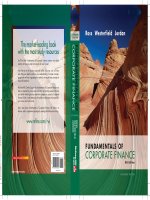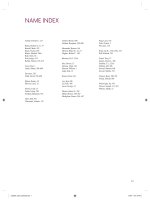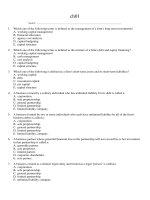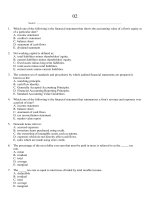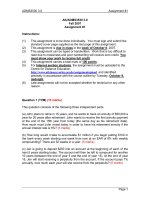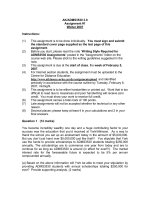final 6 fundamentals of corporate finance, 4th edition brealey
Bạn đang xem bản rút gọn của tài liệu. Xem và tải ngay bản đầy đủ của tài liệu tại đây (144.04 KB, 18 trang )
AK/ADMS 3530.03 Finance Final Exam
Winter 2007
Solutions
Type A Exam
Numerical questions (2 points each)
1. (Q. 5 in B) What is the present value of the following payment stream,
discounted at 8 percent annually: $1,000 at the end of year 1, $2,000 at the end
of year 2, and $3,000 at the end of year 3?
A)
B)
C)
D)
$5,022.11
$5,144.03
$5,423.87
$5,520.00
Answer A
1000
+
2000
(1.08 ) (1.08 )
2
+
3000
(1.08 )
PV =
= $925.93 + $1,714.68 + $2,381.50
= $5,022.11
3
2. (Q. 6 in B) What is the present value of a four-year annuity of $100 per year
that begins two years from today if the discount rate is 9 percent?
A)
B)
C)
D)
$297.22
$323.86
$356.85
$388.97
Answer A
1
1
.09 − .09(1.09)4
PV1
= $100
= $100 [3.2397]
PV1 = $323.97
323.97
PV0 = 1.09
= $297.22
1
3. (Q. 7 in B) $3,000 is deposited into an account paying 10 percent annually, to
provide three annual withdrawals of $1,206.34 beginning in one year. How much
remains in the account after the second withdrawal?
A)
B)
C)
D)
$587.32
$1,096.67
$1,206.34
$1,326.97
Answer B
1,206.34
1.1
= 1096.67
4. (Q. 8 in B) Approximately how much should be accumulated by the beginning
of retirement to provide a $2,500 monthly check (to be paid at the end of each
month) that will last for 25 years, during which time the fund will earn 8 percent
interest with monthly compounding?
A)
B)
C)
D)
$261,500
$323,800
$578,700
$690,000
Answer B
The monthly interest rate is 8% / 12 = 0.667%
PV = $2,500 × [1/0.00667 – 1/(0.00667(1.00667300))]
= $2,500 [129.52]
= $323,800.
5. (Q. 1 in B) An investor buys a ten-year, 7 percent coupon bond for $1,050,
holds it for one year and then sells it for $1,040. What was the investor's rate of
return over the 1-year holding period? Assume coupons are paid annually.
A)
B)
C)
D)
5.71 percent
6.00 percent
6.67 percent
7.00 percent
Answer A
Return on bond = (Interest coupon + Capital gain) / Purchase price of
bond.
2
In our example there was a capital loss of $10 given that the selling price
of the bond ($1,040) was less than the purchase price of the bond
($1,050).
Rate of return = ($70 - $10)/$1,050 = 5.71%.
6. (Q. 2 in B) A bond with 10 years until maturity, an 8 percent coupon rate, and
an 8 percent original yield to maturity increased in price to $1,107.83 yesterday.
What appears to have happened to interest rates? Coupons are paid annually.
A)
B)
C)
D)
Rates increased by 2.00 percent.
Rates decreased by 2.00 percent.
Rates increased by 0.72 percent.
Rates decreased by 1.50 percent.
Answer D
1
1
1000
+
−
i i (1 + i )10 (1 + i ) 10
$1,107.83 = $80
i = 6.5%, yield to maturity was 8.0% prior to the price change. Therefore
the rates have decreased by 1.5%.
7. (Q. 3 in B) Which of the following statements is correct about a stock currently
selling for $50 per share that has a 16 percent expected return and a 10 percent
expected capital appreciation?
A)
B)
C)
D)
Its expected dividend exceeds the actual dividend.
Its expected return will exceed the actual return.
It is expected to pay $3 in dividends for next year.
It is expected to pay $8 in dividends for next year.
Answer C
Expected return = expected dividend yield + expected capital appreciation
16% = expected dividend yield + 10%
6% = expected dividend yield
$50 share price × 6% = $3 expected dividend payment
8. (Q. 4 in B) An investor receives a 15 percent total return by purchasing a stock
for $40 and selling it after one year with a 10 percent capital gain. How much
was received in dividend income during the year?
A)
B)
$2.00
$2.20
3
C)
D)
$4.00
$6.00
Answer A
Percentage return =
capital gain + dividend
initial share price
$40x10% + dividend
$40
15% =
Dividend = $2.
9. (Q. 13 in B) Because of its age, your car costs $4,000 annually in maintenance
expense. You could replace it with a newer vehicle costing $8,000. Both vehicles
would be expected to last four more years. If your opportunity cost is 8 percent,
what would be the maximum annual maintenance expense on the newer vehicle
to still justify its purchase?
A)
B)
C)
D)
$1,250
$1,585
$2,000
$2,415
Answer B
1
1
−
4
.08 .08(1.08)
$8,000 = Annuity
= Annuity [3.3121]
= $2,415.39
When combined with the annuitized cost of the vehicle, any annual
expense over $1,584.61 would place the total annual expense of the new
vehicle over $4,000.
10. (Q. 14 in B) The profitability index for a project costing $40,000 and returning
$15,000 annually for four years at an opportunity cost of capital of 12 percent is:
A)
B)
C)
D)
0.139
0.320
0.500
0.861
Answer A
4
1
1
−
.12 .12(1.12) 4
PV
= $15,000
= $15,000 [3.0373]
= $45,560 and
NPV = $45,560 - $40,000 = $5,560.
Profitability index = $5,560 / $40,000 = 0.139.
11. (Q. 15 in B) What is the minimum number of years that an investment costing
$500,000 must return $65,000 per year at a discount rate of 13 percent in order
to be an acceptable investment?
A)
B)
C)
D)
8.69 years.
14.00 years.
27.51 years.
An infinite number of years.
Answer D
NPV = ($65,000 / 0.13) - $500,000 = 0.
12. (Q. 16 in B) You can continue to use your less efficient machine at a cost of
$8,000 annually for the next five years. Alternatively, you can purchase a more
efficient machine for $12,000 plus $5,000 annual maintenance for the next five
years. At a cost of capital of 15 percent, you should:
A)
B)
C)
D)
Buy the new machine and save $388 in equivalent annual costs.
Buy the new machine and save $600 in equivalent annual costs.
Keep the old machine and save $388 in equivalent annual costs.
Keep the old machine and save $580 in equivalent annual costs.
Answer D
The PV of total cost of the more efficient machine is $28,760.78, which
translates into an EAC of $8,579.79, which is $579.79 higher than the
annual cost associated with the less efficient machine.
13. (Q. 17 in B) What is the approximate IRR for a project that costs $100,000
and provides annual cash inflows of $30,000 for six years?
A)
B)
C)
D)
19.9 percent
30.0 percent
32.3 percent
80.0 percent
Answer A
5
Use the following information to answer Questions 14 – 17 (Questions 9 –
12 in Type B).
Jensen Industries is considering purchasing a new Numerically Controlled
Drilling Press. The press costs $100,000, and belongs to a 15% CCA rate asset
class (declining balance method) and the half-year rule applies. The press is
estimated to have cash flow savings of $34,000 per year for 6 years and will
require an immediate increase in Net Working Capital of $5,000, which will be
recovered when the machine is sold at the end of year 6. Initially assume there is
zero salvage value. The discount rate is 10% and the tax rate is 40%.
14. (Q. 9 in B) What is Jensen’s CCA in Year 1 and Year 2?
A)
B)
C)
D)
$7,500; $12,750
$7,500; $13,875
$15,000; $12,750
$15,000; $13,875
Answer B
CCA in year 1 = $100,000 x ½ x 0.15 = $7,500.
CCA in Year 2 = $(100,000-7,500) x 0.15 = $13,875.
15. (Q. 10 in B) What is the present value of Jensen’s CCA tax shield?
A)
B)
C)
D)
$5,367
$11,667
$19,419
$22,909
Answer D
PVCCATS =
$100,0000 × 15% × 40% 1 + 0.5 × 10%
1 + 10% = $22,909.
10% + 15%
16. (Q. 11 in B) Should Jensen accept the project?
A)
B)
C)
D)
Yes, because the NPV is positive, and it exceeds $10,000.
Yes, because the NPV is positive, although it is less than $10,000.
No, because the NPV is negative, and it is between 0 and -$10,000.
No, because the NPV is negative, and it is between -$10,000 and $100,000.
Answer B
6
NPV=-$105,000 + $34,000(1-0.40)(PVIFA6yr,10%) + $5,000 (PVIF
$22,909 = $9,578.69.
Year
Savings
Tax @ 40%
After-tax savings
Capital Investment
Change in NWC
CFs Excluding CCATS
Discounted CFs
PV of CCATS
NPV
0
-100,000
-5,000
-105,000
-105,000
22,909
$ 9,578.69
1
34,000
13,600
20,400
20,400
18,545
2
34,000
13,600
20,400
20,400
16,860
3
34,000
13,600
20,400
20,400
15,327
4
34,000
13,600
20,400
20,400
13,933
6yr,10%)
5
34,000
13,600
20,400
6
34,000
13,600
20,400
20,400
12,667
5,000
25,400
14,338
+
>0
17. (Q. 12 in B) By how much will the NPV increase if Jensen is able to obtain a
$10,000 salvage value at the end of Year 6?
A)
B)
C)
D)
$1,824
$4,290
$5,645
$6,000
Answer B
NPV increase = PV of salvage value – PV of lost CCATS due to salvage value
$10,000 $10,000 × 15% × 40%
1
−
= $4,290.
6
6
10%
15
%
+
(1
10
%)
+
(1 + 10%)
NPV increase =
18. (Q. 23 in B) What happens to the NPV of a one-year project if fixed costs are
increased from $400 to $600, the firm is profitable, has a 15 percent tax rate and
employs a 12 percent cost of capital?
A)
B)
C)
D)
NPV decreases by $200.00.
NPV decreases by $170.00.
NPV decreases by $151.79.
NPV decreases by $116.07.
Answer C
Fixed costs
+$200
Profit before tax
-$200
Taxes
-$30
change in cash flow= -$200 + $30 = -$170,
which discounts to -$151.79.
7
19. (Q. 24 in B) Fixed costs including depreciation have increased at Leverage,
Inc. from $4 million to $6 million in an effort to reduce variable costs. What must
the new variable-cost percentage be to leave accounting break-even at $20
million?
A)
B)
C)
D)
60 percent
65 percent
70 percent
75 percent
Answer C
$4 million
1 - variable costs = $20 million
Old:
variable costs = 80%.
$6 million
x
= $20 million
New:
x = 30%.
Therefore, variable-cost percentage must reduce from 80 percent to 70
percent to leave the accounting break-even revenues unaffected.
20. (Q. 25 in B) Approximately how much was paid to invest in a project that has
an NPV break-even level of sales of $5 million, annual cash flows determined by:
0.1 × sales – $300,000, a six-year life, and an 8 percent discount rate?
A)
B)
C)
D)
$416,667
$924,576
$1,016,678
$2,311,450
Answer B
PV (cash flows) = investment
1
1
.08 − .08(1.08)6
(0.1 x $5 million – $300,000)
4.6229 ($200,000) = $924,576
8
21. (Q. 26 in B) What percentage change in sales occurs if profits increase by 3
percent when the firm's degree of operating leverage is 4.5?
A)
B)
C)
D)
0.33 percent
0.67 percent
1.50 percent
3.33 percent
Answer B
% change in profits
DOL
= % change in sales
3%
= % change in sales
% change in sales
= 0.67%.
22. (Q. 18 in B) If an asset's expected return is 10 percent, which represents a 20
percent return in a good economy and a 5 percent loss in a bad economy, what
is the probability of a good economy?
A)
B)
C)
D)
60.00 percent
40.00 percent
33.33 percent
18.33 percent
Answer A
p: probability of a good economy; 1-p: probability of a bad economy.
It follows that: 10% = 20% × p + (-5%) × (1- p) ⇒ p = 60%.
23. (Q. 19 in B) What is the approximate standard deviation of returns for a oneyear project that is equally likely to return 100 percent as it is to provide a 100
percent loss?
A)
B)
C)
D)
0 percent
50 percent
71 percent
100 percent
Answer D
9
Mean = (0.5 × 100%) + (0.5 × (–100%))
= 50% – 50%
= 0%.
(100 − 0 )2 + (− 100 − 0 )2
10,000 + 10,000
2
=
2
Variance =
= 10,000
Standard deviation = 10,000
= 100%.
24. (Q. 20 in B) What is the approximate variance of returns (in percentages
squared) if over the past three years an investment returned 8.0 percent, -12.0
percent, and 15.0 percent?
A)
B)
C)
D)
31
131
182
961
Answer B
8 − 12 + 15
3
Mean =
= 3.67%.
(8 − 3.67 )2 + (− 12 − 3.67 )2 + (15 − 3.67 )2
Variance =
3
18.75 + 245.55 + 128.37
3
=
= 130.89 percentages squared.
25. (Q. 21 in B) What is the standard deviation of a five-stock portfolio that
produced portfolio returns of -4%, 2% and 5% with equal probability?
A)
B)
C)
D)
2.90%
3.24%
3.74%
4.58%
Answer C
The equal probability is 1/3.
The portfolio expected return = (1/3)(-4% + 2% + 5%) = 1%.
The portfolio variance = (1/3)[(-4%-1%)2 + (2%-1%)2 + (5%-1%)2]
= 14 percentages squared = 0.0014.
10
Taking the square root of the portfolio variance, we find that the portfolio
standard deviation is 3.74%.
26. (Q. 22 in B) What is the expected rate of return on a portfolio that will decline
in value by 13 percent in a recession, will increase by 16 percent in normal times,
and will increase by 23 percent during boom times if each scenario has equal
likelihood?
A)
B)
C)
D)
8.67 percent
13.00 percent
13.43 percent
17.33 percent
Answer A
1
(- 13 + 16 + 23 ) 1 (26 )
= 3
Expected return = 3
= 8.67%.
27. (Q. 31 in B) If a stock consistently goes up (down) by 1.6 percent when the
market portfolio goes down (up) by 1.2 percent then the stock’s beta:
A)
B)
C)
D)
equals 0.75.
equals 1.33.
equals -0.75.
equals -1.33.
Answer D
It is obvious that the stock’s beta should be negative. Also the stock is an
aggressive stock. The beta of the stock is – 1.6% / 1.2% = -1.33.
28. (Q. 32 in B) Which of the following statements is correct when Treasury bills
yield 7.5 percent and the market risk premium is 9.5 percent?
A)
B)
C)
D)
The S&P 500 would be expected to yield about 8.50 percent.
The S&P 500 would be expected to yield about 9.50 percent.
The S&P 500 would be expected to yield about 12.68 percent.
The S&P 500 would be expected to yield about 17.00 percent.
Answer D
The market portfolio (S&P 500) would yield 7.5% + 9.5% = 17%.
11
29. (Q. 27 in B) When Treasury bills yield 7 percent and the expected return on
the market is 16 percent, then the risk premium on a stock is equal to:
A)
B)
C)
D)
9 percent.
16 percent.
9 percent times the stock's beta.
8 percent plus the risk-free rate.
Answer C
According to the CAPM, the risk premium on a stock = the market risk
premium × β = (16% - 7%) × β = 9% × β.
30. (Q. 28 in B) An investor was expecting an 18 percent return on her portfolio
with beta of 1.25 before the market risk premium increased from 8 percent to 10
percent. Based on this change, what return will now be expected on the
portfolio?
A)
B)
C)
D)
20.0 percent
20.5 percent
22.5 percent
26.0 percent
Answer B
Old: 18% = rf + 1.25(8%)
= rf + 10.0%
8.0% = rf.
New: Expected return = 8.0% + 1.25(10%)
= 8.0% + 12.5%
= 20.5%.
31. (Q. 29 in B) What happens to the expected return on an asset if the asset
beta decreases from 1.5 to 1.2, the risk-free rate increases from 4 percent to 5
percent, and the market expected return decreases from 9 percent to 7 percent?
A)
B)
C)
D)
It increases from 7.4 percent to 11.5 percent.
It increases from 13.4 percent to 17.5 percent.
It decreases from 11.5 percent to 7.4 percent.
It decreases from 17.5 percent to 13.4 percent.
Answer C
12
Before the change: rj = 4% + 1.5 (9% - 4%) = 11.5%.
After the change: rj = 5% +1.2 (7% - 5%) = 7.4%.
32. (Q. 30 in B) A project will generate $750,000 of cash flows annually for four
years. The initial outlay is $2 million. The expected return on Treasury bills is 6
percent and the market risk premium is 8 percent. What is the highest project
beta that will justify acceptance of the project?
A)
B)
C)
D)
0.00
1.00
1.56
2.31
Answer C
$2 million = $750,000 × (PVIFA4 yr, IRR)
IRR = 18.45%.
This suggests a risk premium of 12.45 percent on the project, which
corresponds to a beta of 1.56.
33. (Q. 37 in B) If a firm is 42% debt-financed and the value of equity equals $47
million, which of the following is correct about firm value and the value of debt?
There are only debt and equity in the firm’s capital structure.
Firm value
A) $81 million
B) $47 million
C) $42 million
D) $81 million
Value of debt
$34 million
$81 million
$20 million
$42 million
Answer A
Firm Value = $47M / (1-0.42) = $81M.
Debt = $(81M – 47M) = $34M.
Use the following information to answer Questions 34 – 37 (Questions 3336 in Type B).
Eastman Chemical has 38 million shares of common stock outstanding. The
book value per share is $42 but the stock sells for $58. It also has 700,000, 9
percent semiannual coupon bonds outstanding, par value $1,000 each. The
bonds have 10 years to maturity and sell for 86 percent of par. Eastman’s
common stock is twice as risky as the market portfolio. The firm has 14 million
shares of 5 percent preferred stock outstanding which currently sell for $63 per
13
share. The face value per preferred share is $100. The T-bills yield 5.25%, and
the market risk premium is assumed to be 4.15%. Eastman is in the 35%
corporate income tax bracket.
34. (Q. 33 in B) Eastman’s after-tax cost of debt is:
A)
B)
C)
D)
4.53%
6.45%
6.96%
7.40%
Answer D
On your financial calculator:
FV=1000, PV=-860, N=20, PMT=45; I=? 5.69% Î YTM=5.69 × 2
=11.38%.
After-tax cost of debt = 11.38% × (1-35%) = 7.40%.
35. (Q. 34 in B) Eastman’s cost of equity is:
A)
B)
C)
D)
9.40%
13.55%
14.65%
24.05%
Answer B
By the CAPM: requity = 5.25% + 2 × 4.15% = 13.55%.
36. (Q. 35 in B) Eastman’s cost of preferred stock is:
A)
B)
C)
D)
4.85%
5.00%
6.22%
7.94%
Answer D
The annual dividend paid on per preferred share is $100 × 5% = $5.
So rpreferred = $5 / $63 = 7.94%.
37. (Q. 36 in B) What is the discount rate that Eastman should use to evaluate a
project which is very similar to the firm’s existing business?
A) 8.56%
B) 9.25%
14
C) 11.22%
D) 13.55%
Answer C
Price
Shares (million)
Market Value ($
million)
Weights
Costs
WACC
Equity
58
38
2,204
0.60
13.55%
11.22%
Preferred Debt
63
860
14
0.7
882
0.24
7.94%
602
0.16
7.40%
Value
3,688
Conceptual questions (2 points each)
38. (Q. 43 in B) When a manager does not accept a positive-NPV project,
shareholders face an opportunity cost in the amount of the:
A)
B)
C)
D)
project's initial cost.
project's NPV.
project's discounted cash flows.
soft capital rationing budget.
Answer B
39. (Q. 44 in B) When mutually exclusive projects have different lives, the project
which should be selected will have the:
A)
B)
C)
D)
highest IRR.
longest life.
highest NPV, discounted at the opportunity cost of capital.
lowest equivalent annual cost.
Answer D
40. (Q. 45 in B) When should the net working capital investments be included in
the estimation of cash flows?
A) Never.
B) At the beginning of the project.
C) At the end of a project.
D) Any time during the life of a project.
Answer D
15
41. (Q. 46 in B) Capital budgeting investments are evaluated with the assumption
that projects are:
A) 100 percent -debt financed.
B) 100 percent -equity financed.
C) 50 percent -equity and 50 percent -debt financed.
D) 25 percent -equity and 75 percent -debt financed.
Answer B
42. (Q. 38 in B) If sensitivity analysis indicates none of the individual variables
will cause a negative NPV under pessimistic conditions, then the:
A)
B)
C)
D)
project is assured to be successful.
project's discount rate should be reduced.
economic forecasts are possibly overly optimistic.
interaction of the variables should be considered.
Answer D
43. (Q. 39 in B) The opportunity to alter production technology gives managers:
A)
B)
C)
D)
the flexibility to adapt to changing situations.
increased cash flow from operations.
the opportunity to expand production.
the ability to expand product lines.
Answer A
44. (Q. 40 in B) Which of the following concerns is likely to be most important to
portfolio investors seeking diversification?
A)
B)
C)
D)
Total volatility of each individual securities.
Standard deviation of individual securities.
Correlation of returns between securities.
Achieving the risk-free rate of return.
Answer C
16
45. (Q. 41 in B) The risk premium that is offered on common stock is equal to
the:
A)
B)
C)
D)
expected return on the stock.
real rate of return on the stock.
excess of expected return over a risk-free return.
expected return on the S&P 500 index.
Answer C
46. (Q. 42 in B) The standard deviations of individual stocks are generally higher
than the standard deviation of the market portfolio because individual stocks:
A)
B)
C)
D)
offer higher returns.
have more systematic risk.
do not have unique risk.
have no diversification of risk.
Answer D
47. (Q. 49 in B) Stock returns can be explained by the stock's _________ and the
stock's __________.
A)
B)
C)
D)
beta; unique risk.
beta; market risk.
unique risk; firm-specific risk.
aggressive risk; defensive risk.
Answer A
48. (Q. 50 in B) What will happen to a stock that offers a lower risk premium than
predicted by the CAPM?
A)
B)
C)
D)
Its beta will increase.
Its beta will decrease.
Its price will decrease until yield is increased.
Its price will increase until yield is reduced.
Answer C
49. (Q. 47 in B) Generally speaking, the optimal capital mix that minimizes the
weighted average cost of capital also:
A) maximizes EPS.
B) maximizes share price.
C) minimizes the required rate of return on equity.
17
D) minimizes bankruptcy costs.
Answer B
50. (Q. 48 in B) Firms have various sources of financing. Which one of the
following does not incur flotation costs?
A) Long-term debt.
B) Preferred stock.
C) Common stock.
D) Retained earnings.
Answer D
18
